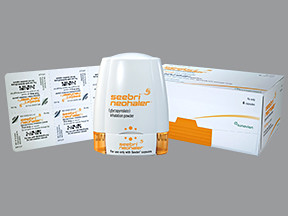GLYCOPYRROLATE POWDER IN CAPSULE - INHALATION
PHONETIC PRONUNCIATION: (GLYE-koe-PIR-oh-late)
COMMON BRAND NAME(S): Seebri Neohaler
GENERIC NAME(S): glycopyrrolate
Uses
USES: Glycopyrrolate is a long term medication used to treat ongoing lung disease such as chronic obstructive pulmonary disease (COPD), including chronic bronchitis and emphysema. It must be used regularly to reduce and prevent symptoms such as shortness of breath and wheezing. This may lead to a decrease in time lost from work due to COPD. This medication belongs to a class of drugs known as anticholinergics. It works by relaxing the muscles around the airways so that they can open wider to make breathing easier. Glycopyrrolate does not work right away and should not be used to relieve sudden breathing problems. If wheezing or sudden shortness of breath occurs, use your quick-relief inhaler as prescribed.
How to use GLYCOPYRROLATE POWDER IN CAPSULE - INHALATION
HOW TO USE: Read the Patient Information Leaflet provided by your pharmacist before you start using glycopyrrolate and each time you get a refill. Follow the illustrated directions for the proper use of this medication. If you have any questions, ask your doctor or pharmacist. Do not swallow these capsules. Use only the special inhaler that comes with the medication to inhale the powder in the capsules. Inhale this medication by mouth as directed by your doctor, usually once or twice daily, depending on the brand that you use. Leave the capsule sealed in the blister packet until just before use. Dry your hands before touching the capsules. Do not push the capsule through the foil. Follow the instructions for loading the capsule into the inhaler and for piercing it. Inhale rapidly and deeply through the mouthpiece. You should hear a whirring noise as you inhale the medication. You will also have a sweet taste from the medicine. Hold your breath for at least 5 to 10 seconds. Open the inhaler to see if any powder is left in the capsule. If there is, close the inhaler and inhale again. Inhale all of the powder from each capsule. Do not blow into the mouthpiece at any time. Avoid getting this medication into your eyes. It may cause eye pain/irritation, temporary blurred vision, and other vision changes. If you are using other inhalers at the same time, wait at least 1 minute between the use of each medication. Use this medication regularly to get the most benefit from it. To help you remember, use it at the same time(s) each day. Do not increase your dose or use this drug more often than prescribed, or stop using it without first consulting your doctor. Do not wash the inhaler with water. You may wipe the mouthpiece inside and outside with a clean, dry, lint-free cloth. Learn which of your inhalers you should use every day and which you should use if your breathing suddenly worsens (quick-relief drugs). Ask your doctor ahead of time what you should do if you have new or worsening cough or shortness of breath, wheezing, increased sputum, waking up at night with trouble breathing, if you use your quick-relief inhaler more often, or if your quick-relief inhaler does not seem to be working well. Learn when you can treat sudden breathing problems by yourself and when you must get medical help right away. Tell your doctor if your symptoms do not improve or if they worsen.
Side Effects
Precautions
Interactions
Overdose
Images

- color
- orange
- shape
- oblong
- imprint
- logo, GPL15.6

- color
- orange
- shape
- oblong
- imprint
- logo, GPL15.6

- color
- orange
- shape
- oblong
- imprint
- logo, GPL15.6
Reviews
Disclaimer
IMPORTANT: HOW TO USE THIS INFORMATION: This is a summary and does NOT have all possible information about this product. This information does not assure that this product is safe, effective, or appropriate for you. This information is not individual medical advice and does not substitute for the advice of your health care professional. Always ask your health care professional for complete information about this product and your specific health needs.
No Reviews Yet